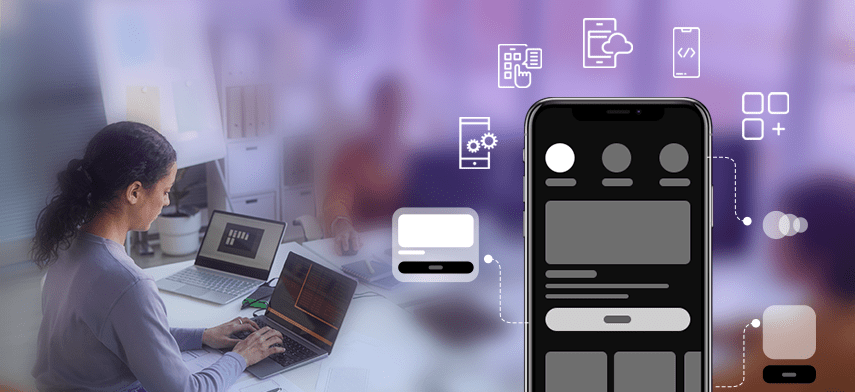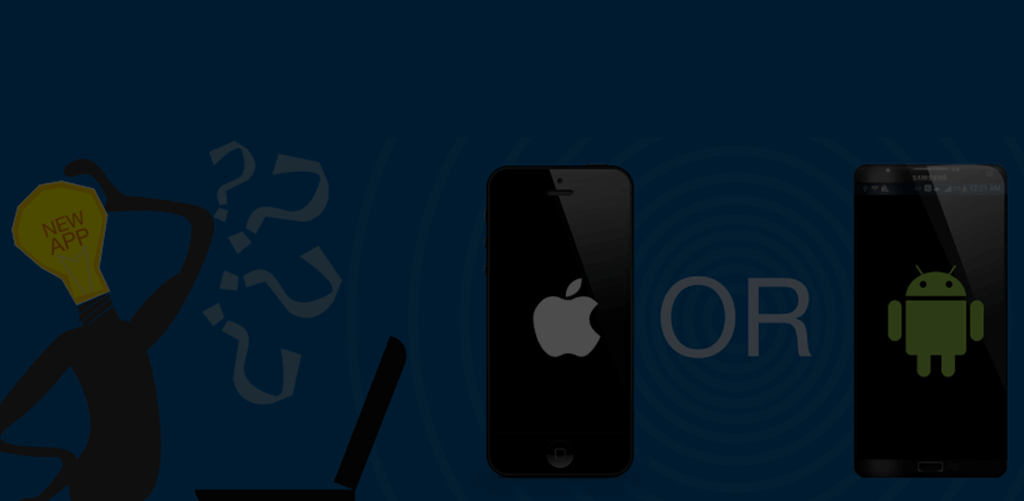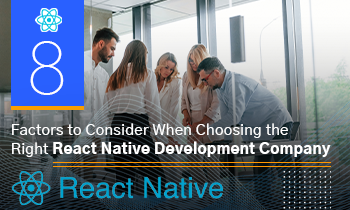This blog series highlights the most important step of your mobile app development process after creating the design and prototype – ‘Development’. Our professionals have compiled a list of standards to be taken care of while building your application. You’ll also come across different mobile app development methodologies that would help you establish a highly responsive final product.

Furthermore, you can go through our checklist of key app development elements that should not be neglected at any cost. Indeed, we’ll help you select the best technology stack and guide you along the best coding practices to boost your app-building process.
But first, let’s understand what mobile app development exactly means and what’s in it for you.
What is Mobile Application Development?
Mobile app development is a combination of procedures and processes that involve coding software for portable, wireless computing devices like smartphones and other hand-held devices. Having its roots in traditional software development, this combination takes full advantage of the in-built features of a specific mobile device. For instance, a gaming app can be written to regulate an iPhone’s accelerometer.
Today, the two most renowned mobile platforms to develop apps for are Android and iOS. However, before developing one, you need to determine the type and make necessary adaptations to your app development cycle to deliver the best.
Here’s an informative breakdown of the major types of application development to help you make the best pick.
1 Native Apps
You need to bring the best Integrated Development Environments (IDEs) on board to build such types of apps. It also involves using programming languages for mobile Operating Systems (OSs) like iOS and Android. With such an app in hand, you can customize essential features. But you need to invest a good amount of time and capital in developing one.
2 Hybrid Apps
These are web applications that behave like native applications. Such a type of app development requires the comprehensive use of technologies like Cascading Style Sheets (CSS), HTML, and JavaScript. Compared to native apps, these apps are cost-effective to build. They aren’t feature-rich but can be created at a faster rate.
3 Progressive Web Apps (PWAs)
A PWA is a type of app software delivered through the web with all the benefits of a mobile application and can be developed with web-based technologies like Facebook React. It can be built and augmented with modern Application Programming Interfaces (APIs) to deliver the utmost reliability and usability on any device via a single codebase.
4 Encapsulated Apps
These types of apps run within a container app and can accelerate the mobile app development process. For example, products like the Microsoft Power App drag-and-drop app development tool helps developers to create mobile apps quickly. However, the absence of isolation from the core OS can result in a few complications.
Industry Standards for Mobile App Development
As you have come across the types of apps, you now need to consider and understand the key industry standards for developing them. It’s pertinent to abide by these standards to establish your brand in the market and create a perfect road map for:
- User safety assurance
- Promoting collaboration
- Satisfying customized requirements
- Avoiding potential barriers
- Delivering the right app understanding
- Ensuring platform-specific results
Let’s take a look at some of the important standards.
1 Complete Visibility
It’s important for mobile app developers to create an app that provides users with prior notice for data access, collection, and transmission. You need to make sure that your mobile app gives enough visibility through a consent mechanism, especially while accessing sensitive and crucial data.
2 Data Management and Retention
Your final product should utilize user data only for legitimate purposes. It should delete the information which isn’t required to be retained from the device, servers, and cloud. The app should consider all the data retention periods and encourage the privacy interests of the users by following a no-data compromising framework.
3 Risk Mitigation
Your app should follow all the mobile app security standards like understanding the security risks and collateral damage (user data), thereby avoiding any kinds of vulnerabilities. It should enable data storage without proving inconvenient to the users, disrupting their devices, or causing any harm to its existing features and functionalities.
4 Data Encryption
When authenticating, your mobile app should follow the thumb rule of end-to-end encryption for all the data in transmission. Be it session data, information related to onboarding, or any other personal details like passwords, addresses, and usernames, the app should properly encrypt it to avoid unwanted issues related to unsecured Wi-Fi networks and insecure connections.
5 Feedback Provision
You need to code your application in such a way that your users can contact your team easily and raise their concerns, complaints, and queries seamlessly. It should give the necessary opportunities to your users to provide their feedback. Your app should have a one-stop facility to handle user responses and address them accordingly.
6 De-Identification
Another significant standard to include in your mobile app development process is focusing on de-identifying user data. You need to ensure that your developers write the app in such a way that it attains the potential to clean different identifiable elements of the user’s personal information, making it much more user-friendly than ever before.
How to Approach Mobile Application Development?
After getting hold of the above standards, it’s time to adopt an app development methodology that suits your project requirements and enables your brand to create a highly scalable app within the stipulated timeline.
There are many helpful methodologies to make your mobile app development life cycle less complicated and more impactful. We’ll discuss them one by one to help you choose a methodology that best suits your business needs.
1 Waterfall
This methodology is a sequential software development process that involves finishing one phase before entering the next. Also known as the waterfall model, it demands complete documentation of your project in advance. It can prove expensive when wanting to make alterations as its phases are organized in a linear order.
However, this linear ordering helps identify the end of a phase and the beginning of the others. Another determining factor is that the output of one phase becomes the input for the next and should not be changed or modified.
2 Agile
This development method distributes the products in different cycles and creates a functional app rapidly. Most companies use it to introduce the scrum software development process across their complex app projects. This process provides next-level transparency and flexibility to sustain compound operations.
With a scrum framework, your developers can create a sprint software development environment to define a set period of time in which a particular operation is to be completed and established for review.
3 Iterative
The iterative enhancement app development methodology is a type of increment model where each increment adds some functional ability to your application until its complete execution. This model emphasizes repetition and creates an app version real quick with a little budget. Later, this version can be checked and modified via successive versions.
What makes this method more important is that it offers a better testing environment for determining the final requirements of your mobile app. It also helps in making a future-ready app whose progress can be measured rationally.
4 Big Bang
This is the perfect app development method to cater to the requirements of small mobile app projects. This method doesn’t involve any kind of process or procedures to follow. It just demands you to focus on all the potential resources in software creation and coding, with a decent set of requirements in hand.
This method gives good flexibility to your developers as it’s simple, easy to understand, and can be managed effectively. However, you cannot rely on it to satisfy even the basic requirements of complex and object-oriented projects.
5 Spiral
This methodology is an amalgamation of iterative and waterfall models. It combines the interaction capabilities with systematic, controlled aspects of sequential linear development to release the final product. This method is committed to the high emphasis on risk analysis and makes gradual improvements to support the process.
The spiral model is flexible enough to fulfill all the requirements for medium to high-risk projects. It divides the mobile app development process into smaller parts by which changing needs can be managed and accommodated effortlessly.
6 Object-oriented
It’s a type of software engineering method where your developers identify and organize the app with respect to object-oriented concepts before their final representation in any particular development tools or programming languages. It focuses on objects early in the development that results in delivering a useful product.
This method can use an encapsulation and data hiding process to help developers build tamper-proof applications. It allows software modularity to manage and regulate complicated software projects at ease.

Mobile Application Development
Choosing one of the above-mentioned methodologies is not the only factor to streamline your development process. There are some other things to be taken care of to approach this process the right way.
Let’s take a look at them.
1 Mobile App Development Application Architecture
Application architecture is a collation of certain techniques and patterns that help your developers build a successful application. You need to choose the best that can support all the stages of mobile app development. And neglecting it would surely drive your brand towards huge losses. Here’re some of the most popular architectures.
- Layered
Also known as N-tier, experts highly recommend this architecture to develop on-premise and enterprise apps. Its tier pattern helps to manage dependencies and perform logical functions.
- Monolithic
Monolithic architecture is associated with legacy applications, and updating its single aspect can impact your entire app. It observes a tightly coupled technique to represent service interaction and how it’s developed and delivered.
- Service-oriented
It’s a well-established development architecture that optimizes your app into discrete, reusable services. Each individual service is organized to suit a particular business process and communication protocol like Apache Thrift.
- Microservices
It stands among the best application architecture models that act as an approach to writing software. Here, your app development gets separated into smaller, well-distributed, and loosely coupled microservices.
- Event-driven
This architecture allows minimal coupling that can help your developers in building contemporary applications. Here, the events are captured via IoT devices and other communication networks.
2 Technology Stack
The entire technology stack for your mobile app development process can be divided into four core areas that specifically shape the anatomy of your application. The areas are as follows:
- Frontend – The part through which users interact with your application.
- Backend – The part that receives user inputs, processes and converts them to successful outputs.
- Development Platform – The interfaces and libraries carry out all the necessary functions to develop the application.
- Add-on – The fundamental technology elements that influence app performance, security, and robustness.
To outline all the above areas effectively, you should have a comprehensive suite of all the below-mentioned components and ensure that they meet all the requirements of your custom mobile app.
- Application Programming Interfaces (APIs)
Mobile APIs are necessary to bring your brand’s massive amounts of data into use on any mobile device. They offer easy integration with third-party apps and perform rapid delivery. Engaging with the right APIs can help your developers to access and manage data efficiently. Firebase and Appcelerator are good examples of some popular APIs.
- Programming Languages
You can choose Swift or Objective-C for building an iOS app. But if you want to develop an android app, then you must definitely go for Kotlin. You can also go for the popular Python language or even consider C++ with object-oriented features to develop high-end apps. Besides, there are many other languages you can opt for as per your requirements.
- App Development Frameworks
A library that offers the needed structure to build mobile apps is known as a framework. So, making the right pick would be a step towards good development speed, manageability, and accessibility. Swiftic, Native Scripts, React Native, Xamarin, Ionic, and Corona are some of the popular frameworks, to name a few, to satisfy your Android and iOS platform needs.
- Software Development Kits (SDKs)
SDKs are a set of software tools and programs that help developers build apps for specific platforms. These tools shall include code samples, IDEs & code editors, guides, documentation, and libraries that can be used and seamlessly integrated into your apps. Most developer-friendly SDKs include Android Studio, Xcode, Visual Studio, etc.
3 Coding
After understanding and arranging all the above elements for your development process, you can start programming your app. Just make sure your developers write the code as per these phases:
- Initiation
Here the first step relates to analysis and specification for the programming and what are its prime objectives. The developed algorithm should be an unambiguous logical sequence of steps. This algorithm should be verified to achieve the expected outcomes.
- Execution
To develop a good app, you need to translate your algorithm into a program written in a programming language of your choice. You need to test this program for any kinds of syntactical and logical errors and fix them immediately.
- Implementation
The final program should have the potential to solve real-world problems and prove to be an asset, whether you’re coding apps for iOS or Android platforms. You need to implement the code in accordance with the app development standards.
How to Select the Best Tech Stack for Mobile App Development
We covered all the essential elements for your technology stack to stand out. Now, we’ll discuss the major factors that influence the choice of the stack and help you develop an app that perfectly suits your unique business needs.
1 App Needs
As said earlier, you need to be clear about the type of app you want to develop. This shall help you choose the tech stack that satisfies all the application needs like the device on which it would function, the network conditions for it to operate, and much more.
2 Set Goals
Your choice of the tech stack totally depends on the goals you want to achieve with your mobile application. There would be a huge difference between the technologies you choose for a high latency mobile app as compared to a quick response, low latency app.
3 Development Team
You need to make a pick after analyzing the skillsets of your in-house/ onsite development team. Ensure that your team is well-acquainted with the technologies you choose and have good knowledge to handle them without complications.
4 Platform Compatibility
The tech stack of a mobile app that runs only on a single platform would be much different than that with the capabilities to run on multiple platforms. For instance, a native app would outline a different toolset than the tools used for developing a cross-platform app.
5 Security Check
Every mobile app development technology is committed to countering security-related vulnerabilities and bugs during the development. You just need to make sure that the one you select is sufficiently documented and doesn’t require writing a long line of code.
6 Existing Tool Flexibility
Sometimes you want to add another set of tools after initiating your mobile app development process. As such, it’s necessary to choose the tech stack that is compatible with your current tools as well as the tools that you’re going to incorporate in the later stages.
7 Timeline and Budget
One of the most important things to consider while determining the technologies is your set budget and timeline. Ideally, you need to define all the essential needs of your app and its related cost and which toolset can complete it on time.
Best Coding Practices to Follow in 2021 and Beyond
After choosing the technology stack and creating a flexible mobile app development environment, you have to follow some key coding practices to help you and your team achieve the expected results.
1 Adhere to the Style Guide
One of the most important coding practices is to follow a particular style guide. This helps get detailed insights into how to indent your code, naming conventions, place braces & spaces, etc., to keep your code easy to read.
2 Prioritize Code Readability, Consistency, and Conciseness
Ensure that your code is easily readable and maintains the same level of consistency across the entire software development process. It should be crisp, concise, thoroughly optimized, and error-free to avoid any types of complications.
3 Comment and Documentation
Develop the habit of starting each function or method with a comment. Make sure you define what your function or method does, the parameters it follows, and probable outcomes it generates while commenting and documenting the code as a whole.
4 System-independent Code
Your coding strategy should be system-independent in such a way that the code written on one system can be easily executed on another. This helps to run source code on various available platforms irrespective of the technical specifications of a device.
5 Practice Line Length Limitations
Limiting your line length to a certain number of characters is another important coding practice to take into account. Following this can help you in splitting your code into short and more focused units.
6 Focus on OOP Features
You need to align your code to the Object-oriented Programming (OOP) features like:
- Data Abstraction – The code should be capable of hiding complex implementation details from its users.
- Inheritance – It should inherit properties from others. For example, a class should inherit the properties and functions of the base class.
- Encapsulation – It should bind the data with function while exploiting it.
- Polymorphism – Depending upon the class and data type used, the function must have the ability to take more than one form.
The Final Words
As a business owner, you always want your mobile app development process to be hassle-free. And by rightly understanding and implementing all the above essentials, you can surely move one step closer to achieving it. You can also contact us and hire mobile app developers that’ll not only guide you through the entire process but help you build a mobile app that your users would love to interact with.

Author's Bio

Nitin Lahoti is the Co-Founder and Director at Mobisoft Infotech. He has 15 years of experience in Design, Business Development and Startups. His expertise is in Product Ideation, UX/UI design, Startup consulting and mentoring. He prefers business readings and loves traveling.


